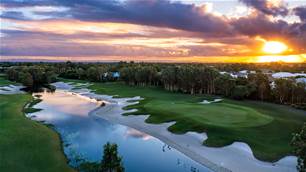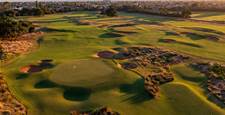For the golfing holidaymaker, the picturesque stretch of Queensland coastline incorporating Bribie Island in the south to Noosa Heads in the north has it all.
MALENY GC
After 20 years of planning, consultation and construction – employing volunteer labour and wisdom, Maleny Golf Club finally celebrated the opening of its completed 18-hole course in February last year.
A plan for the course was first tabled in 1999, but construction on the course did not start until 2014 after an extensive community consultation. With a budget of just $1.6 million, construction was primarily done by volunteers and supported by local contractors and saw the first nine holes opened in 2015.
The course – designed by renowned architect Graham Papworth and inspired by the origins of the game in Scotland – covers about 25 percent of the Maleny Community Precinct, with the remaining land being devoted to other sports as well as heritage, walking paths, rainforest and wetlands.
“This day marks the end of the club’s rather long beginning and start of a bright future as the home of golf in the Sunshine Coast Hinterland,” Club President Jeff Kruse said at the opening.
“Our course superintendent Mick McCombe has really worked miracles with volunteers and contractors to oversee the transformation of dairy pastures and some dense weedy patches into a quality course. In the process he won two national and one state awards for excellence.”

Just weeks after the official opening, COVID-19 made its way into Australia closing borders and forcing some regions into lockdown. But the ‘new’ par-68 course got a publicity shot in the arm during lockdown when 2013 Masters Champion Adam Scott live-streamed a round of golf with the Maleny’s resident pro and mate Wayne Perske.
In an earlier round at the course, Scott set Maleny’s course record with a 62, which included a double bogey on the opening hole.
It’s easy to see how Scott could have stumbled at the 1st hole – a 136-metre par-3 that is played from an elevated tee over a deep gully to an angled green, which slopes markedly from right-to-left. The green is actually terraced into a hillside and a rock wall beneath the low side of the putting surface creates a steep drop-off and any ball finishing at the base of the wall will leave a nigh-impossible recovery shot.
The following hole is perhaps my favourite. It is a big sweeping downhill right-to-left par-5 of 468-metres with out-of-bounds right and an environmental wetland hazard lining the left side of the fairway. Second and third approach shots will all be played from a downhill lie to a two-tiered green, protected in front by a lone bunker. Any player keen on making four or better here, almost certainly will bring bogey or worse into play.
Maleny offers plenty of fun and challenging shots. It is a course that is a shining example of the high standard of golf that can be achieved on a limited budget with a committed membership.
Green fee: $38 (18 holes).
PELICAN WATERS GOLF CLUB
Pelican Waters is one of the finest Australian examples of how modern golf course designers can create a top layout just about anywhere.
Designers Greg Norman and Bob Harrison turned flood-prone land just south of Caloundra into one of Queensland’s finest courses. In fact, the 6,289-metre par-72 home of the Queensland Open was listed at No.29 in Golf Australia magazine’s Top-100 Public Access Course ranking in January this year.

During their years together as a design team, Norman and Harrison, who are both keen students of the design work of Dr Alister MacKenzie, turned the design clock back almost a century to create layouts with short par-4s, risk-and-reward par-5s and the occasional punchbowl green. Pelican Waters is no different.
The layout is due to undergo a major remodelling with some holes being lost to accommodate 270 home sites. Construction on new holes is due to begin later this year, so there is only limited time remaining to play Norman and Harrison’s original course.
Green fee: $85 (18 holes with cart).
CALOUNDRA GOLF CLUB
Caloundra Golf Club is a traditional bushland course where accuracy and good shot-making are demanded by the tree-lined layout.
The par-71 has some very impressive holes surrounded by lush vegetation that is home to kangaroos and a wide variety of birds, including rainbow lorikeets and galahs. The terrain varies from relatively flat to undulating, with some of the best holes covering the more dramatic landscape.

The front nine features back-to-back 500-metre-plus par-5s but it is the first of these – the 515-metre 4th hole – that is a true gem. You can’t see the green from the tee as your drive must carry a lake to find the fairway, which climbs up and over the crest of a hill that slopes markedly down from right-to-left. Hit the high right side of the fairway and there is a plenty of run as you head over the hill and turn slightly left heading for the green. A decision needs to be made as to whether you lay-up or carry the burn about 50 metres short of the slightly elevated putting surface. This is a terrific three-shotter where players of all abilities can excel or come a cropper.
Another aspect to like about this course is the variety of hole shapes that call for fades and draws from the tee. Not one shape dominates, which certainly adds to the shot-making appeal of the Caloundra course.
Green fee: $55 (18 holes).
HEADLAND GOLF CLUB
The vista confronting you as you round the corner of the clubhouse from the Headland Golf Club carpark en route to the pro shop
is impressive.
The view of the Mooloolaba coastline from the Buderim-based club is one of the best on the Sunshine Coast and adds to the memorable round you will have at Headland – a well-designed course that has been hosting visiting golfers since starting as a nine-hole course back in 1958. Just over seven years later, the course was extended to 18 holes. While the routing has been tinkered with only slightly during the past 45 years, most of the major changes have been to the greens, lengthening of holes and the creation of new tees.
Today, Headland is a modern layout with large, rolling greens covered with beautifully maintained Bermuda grass.

Vast tracts of the layout can be seen from the clubhouse balcony but some of the best holes are across the lower reaches of the course and cannot be seen. By far the best of these is the 341-metre par-4 12th, which is one of the more visually impressive holes on the Sunshine Coast. Coming out of a chute created by a wall of trees left and right, the drive needs to be into the right half of the fairway to avoid kicking left toward the lake that comes into play about 150 metres from the tee. The lake then closely hugs the left edge of the short grass all the way to the long green, which is protected by a sole bunker cut into the short, left fringe. By far the best miss with your approach is to the right, but even then you will need to chip over some mounds onto the green.
The 12th is the first of an impressive and challenging sequence of holes leading back to the clubhouse, with the long par-4 15th and 16th holes being the challenging highlights of the round.
Green fee: $58 (18 holes).
TWIN WATERS GOLF CLUB
With its spacious, rippled fairways, outstanding putting surfaces and vast tracts of sub-tropical vegetation, Twin Waters has been a leading fixture of Sunshine Coast golf ever since the Peter Thomson and Mike Wolveridge design opened for play three decades ago.
The course doesn’t appear to be the most difficult test around yet it plays far tougher than first impressions suggest. Thomson and Wolveridge mix of expansive and pot bunkers are dotted across or alongside most fairways, all designed to swallow anything bouncing near them. The greens are mostly broad and feature gentle, rather than wild, undulations but those subtleties ensure they can be difficult to read. Many are ‘push-up’-style putting surfaces with runoffs that turn many a good iron shot into a missed green and a challenging up-and-down.
Arguably the most memorable hole at Twin Waters is the 379-metre 8th, which bears a slight resemblance to the Road Hole at the Old Course at St Andrews. Rather than driving across a hotel, however, the carry here is across a lake and bunkers before a tough approach to a raised green with a single, deep pot bunker guarding the left side and all manner of strife over the back.

Twin Waters’ closing holes offer contrasting fortunes. The 17th is a devious long par-3 with no margin for error and almost zero chance to bounce the ball onto the green from the 202-metre back tee, while the 18th is a reachable par-5 of just 462 metres to a big green fronted by a steep, thick grass-covered bank.
Twin Waters has been a mainstay of Golf Australia magazine’s Top-100 Public Access Courses ranking for the past decade. In January this year, the layout was placed at No.56 in the country.
Green fee: $82 (18 holes).
Related Articles

Drinks With... Ricky Ponting

International Spotlight: Omanu Golf Club








_15th_hole.jpg&h=115&w=225&c=1&s=1)




